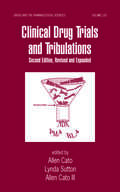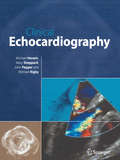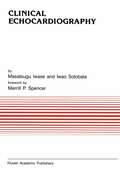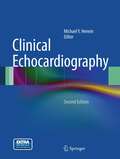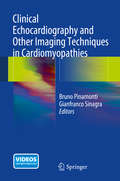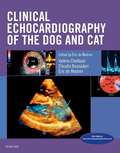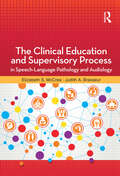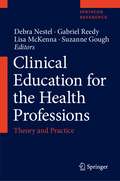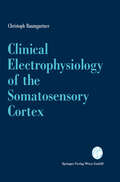- Table View
- List View
Clinical Drug Trials and Tribulations, Revised and Expanded
by Allen Cato Allen Sutton Allen Cato IIIAimed at those already involved in drug development or those considering entering the field, Clinical Drug Trials and Tribulations, Second Edition comprehensibly addresses the new, day-to-day challenges of drug development with valuable assessments of the areas affecting the conduction of nonclinical and clinical studies.Addressing which de
Clinical Echocardiography
by Michael Y. Henein Mary Sheppard John Pepper Michael Rigby-Integrates the investigation of the echocardiographic findings with the pathologic, clinical and surgical aspects of heart disease -Includes stunning color echocardiographic images of various heart diseases with reference to their pathologic appearance and physiology -Includes clinical comments on patient management, which is not included in other echocardiography texts
Clinical Echocardiography (Developments in Cardiovascular Medicine #95)
by M. Iwase Iwao SotobataRecently, much progress has been made with echocardiography and Doppler techniques and these ultrasound methods have grown in importance and reliability as non-invasive diagnostic procedures for many cardiovascular disorders. The objective of this t~xtbook is to offer a detailed yet concise overview of the echocardiographic diagnosis of the various cardiovascular diseases. The book focuses upon the practical echocardiographic (including Doppler) exam ination. Accordingly, the fundamental principles of echocardiography and the Doppler techniques (pulsed and continuous wave and color flow mapping are covered briefly but comprehensively). A copious amount of representative figures and illustrations is included so that the reader is able to understand the clinical application of each modality in the various cardiovascular pathologies and the echocardiographic diagnosis. In keeping with the concept of an integrated echocardiographic examination, the two-dimensional, M-mode and Doppler echocardiographic findings are included in many of the diseases. Usually, the echocardiographic examination is approached first by two-dimensional imag ing to give an understanding of the anatomical correlations, if necessary adding M-mode to clarify the time course of intracardiac movements, and secondly by each Doppler technique to evaluate the hemodynamic conditions. When familiar with these approaches, one can make not only the diagnosis of many cardiovascular diseases with echocardiography alone, but also the rational and expeditious management of patients. Today, some of the cardiac diseases (Atrial Myxoma, Atrial Septal Defect, Infective endocarditis and so forth) have been oper ated based only on echocardiographic findings.
Clinical Echocardiography
by Mary Sheppard John R. Pepper Michael Rigby-Integrates the investigation of the echocardiographic findings with the pathologic, clinical and surgical aspects of heart disease-Includes stunning color echocardiographic images of various heart diseases with reference to their pathologic appearance and physiology-Includes clinical comments on patient management, which is not included in other echocardiography texts
Clinical Echocardiography and Other Imaging Techniques in Cardiomyopathies
by Bruno Pinamonti Gianfranco SinagraThis book describes the role of basic and advanced imaging techniques in the diagnosis of different types of cardiomyopathy, including dilated cardiomyopathy, hypertrophic cardiomyopathy, restrictive cardiomyopathy, arrhythmogenic right ventricular cardiomyopathy and infiltrative/storage cardiomyopathies. While the main focus is on echocardiography, the applications of cardiac magnetic resonance imaging and computed tomography are also described. Throughout, a clinically oriented approach is employed: detailed attention is paid to differential diagnosis and numerous high-quality images depict the main features of the various types of cardiomyopathy. Consideration is also given to the genetics of cardiomyopathies, with analysis of genotype-phenotype relationships. Finally, the potential value of imaging in prognostic assessment and in guiding treatment is described.
Clinical Echocardiography of the Dog and Cat - E-Book
by Eric de Madron Valérie Chetboul Claudio BussadoriCovering both classical modalities of echocardiography and newer techniques, Clinical Echocardiography of the Dog and Cat shows how to assess, diagnose, and treat canine and feline heart disease. A clinical approach demonstrates how these modalities may be used to acquire images, and then how you can recognize and identify patterns, relate them to different diseases, and manage patient care with those findings. The print book includes a companion website with 50 videos of cardiac ultrasound exams and procedures. Written by veterinary cardiology specialists and echocardiographers Eric de Madron, Valerie Chetboul, and Claudio Bussadori, this indispensable echocardiology resource is ideal for general practitioner veterinarians as well as specialists, including cardiologists and radiologists.Dedicated coverage of canine and feline echocardiography emphasizes a more in-depth discussion of cardiac ultrasound, including the newest ones such as Tissue Doppler and speckle tracking imaging, and transesophageal and 3D echocardiography.A practical, clinical approach shows how these echocardiographic modalities are not just research tools, but useful in diagnosing and staging heart disease in day-to-day practice. Book plus website consolidates offers current information into a single cohesive source covering classical modalities and newer techniques, as well as updates relating to normal echocardiographic examinations and values.50 videos on the companion website demonstrate how to perform echocardiography procedures, illustrating points such as swirling volutes, color flow display of blood flows, dynamic collapses secondary to pericardial effusion, and tumors flicking in and out of the echocardiographic field. A section on presurgical assessment helps you assess risk and prepare for catheter-based correction of cardiac defects — accurate measurements and proper device selection are key to a successful procedure.Over 400 full-color illustrations and 42 summary tables help you achieve precise, high-quality imaging for accurate assessment, including photographs of cadaver animal specimens to clarify the relationship between actual tissues in health and disease and their images.
The Clinical Education and Supervisory Process in Speech-Language Pathology and Audiology
by Elizabeth McCrea Judith BrasseurAs with the actual practices of speech-language pathologists and audiologists, clinical education and supervision practices work best when they are grounded not only in concept and theory but also in research. Designed to act as a complete guide to both the theory and the research, The Clinical Education and Supervisory Process in Speech-Language Pathology and Audiology provides the most up-to-date information on these crucial topics. Following in the footsteps of their mentor, Jean Anderson, Drs. Elizabeth McCrea and Judith Brasseur have taken on the task of assembling important current research and best practices in clinical education and supervision into one comprehensive resource. With their prestigious team of contributing authors, this text represents the culmination of decades of study and real-world best practices.The Clinical Education and Supervisory Process in Speech-Language Pathology and Audiology covers clinical education and supervision across five unique constituent groups: clinical educators of graduate students, preceptors of audiology externs, mentors of clinical fellows, supervisors of support personnel, and supervisors of professionals transitioning between work settings. It also includes the latest information on certification and accreditation requirements for preparation in supervision.Topics include Foundations: Anderson’s Continuum of Supervision Components of the Process Expectations for Supervision Practical Research in Supervision Literature from other Disciplines Obtaining Feedback About the Supervisory Process The Ethics of Clinical Education and Supervision Supervisor Self-Study and Accountability Interprofessional Education and Practice in Clinical Education and Supervision Chapter appendices add numerous ancillary materials, allowing readers to easily adopt the most successful processes and strategies the research has revealed. Sample scripts of supervisory conferences, self-assessment tools, action plan tools, and analysis systems can all be found inside.The Clinical Education and Supervisory Process in Speech-Language Pathology and Audiology is intended as a primary resource for anyone in those professions in any setting who is engaged in the process of clinical education and supervision. With this text as their guide, clinical educators and supervisors will be able to ground their practices in the vast compiled research and study contained within.
The Clinical Education and Supervisory Process in Speech-Language Pathology and Audiology
by Elizabeth McCrea Judith BrasseurAs with the actual practices of speech-language pathologists and audiologists, clinical education and supervision practices work best when they are grounded not only in concept and theory but also in research. Designed to act as a complete guide to both the theory and the research, The Clinical Education and Supervisory Process in Speech-Language Pathology and Audiology provides the most up-to-date information on these crucial topics. Following in the footsteps of their mentor, Jean Anderson, Drs. Elizabeth McCrea and Judith Brasseur have taken on the task of assembling important current research and best practices in clinical education and supervision into one comprehensive resource. With their prestigious team of contributing authors, this text represents the culmination of decades of study and real-world best practices.The Clinical Education and Supervisory Process in Speech-Language Pathology and Audiology covers clinical education and supervision across five unique constituent groups: clinical educators of graduate students, preceptors of audiology externs, mentors of clinical fellows, supervisors of support personnel, and supervisors of professionals transitioning between work settings. It also includes the latest information on certification and accreditation requirements for preparation in supervision.Topics include Foundations: Anderson’s Continuum of Supervision Components of the Process Expectations for Supervision Practical Research in Supervision Literature from other Disciplines Obtaining Feedback About the Supervisory Process The Ethics of Clinical Education and Supervision Supervisor Self-Study and Accountability Interprofessional Education and Practice in Clinical Education and Supervision Chapter appendices add numerous ancillary materials, allowing readers to easily adopt the most successful processes and strategies the research has revealed. Sample scripts of supervisory conferences, self-assessment tools, action plan tools, and analysis systems can all be found inside.The Clinical Education and Supervisory Process in Speech-Language Pathology and Audiology is intended as a primary resource for anyone in those professions in any setting who is engaged in the process of clinical education and supervision. With this text as their guide, clinical educators and supervisors will be able to ground their practices in the vast compiled research and study contained within.
Clinical Education for the Health Professions: Theory And Practice
by Debra Nestel Gabriel Reedy Lisa McKenna Suzanne GoughClinical Education in the Health Professions: An Educator's Guide
by Clare Delany Elizabeth MolloyClinical settings are dynamic educational spaces that present both opportunities and barriers to learning and teaching. Designed to inform, challenge and educate health professionals about the evidence underpinning clinical education practices and outcomes, this multi-disciplinary book brings together important concepts in healthcare education and addresses context and processes of learning, professional identity and socialisation, feedback and assessment, ethics, and inter-professional education. The authors encourage teaching and learning practices based on research findings, expertise and innovation, and the development of individual teaching methods and styles from a theoretical base that provides relevant principles, direction and support. With clear links between theory, research and practice, collaboration from a broad range of clinical disciplines, and models for learning and teaching grounded in empirical research, Clinical Education in the Health Professions will become a standard reference for all health professionals and educators.examines patterns of practice in clinical education in the health professions, using a qualitative research focusidentifies the roles of university and clinical educators, students, peers and patients in clinical education highlights implicit tensions in clinical education practice and presents strategies to identify and address such tensionschallenges the reader to consider new approaches to clinical education that may optimise students’ learning and enculturation into the health professionsDespite claims that clinical education lies at the heart of health care education, little empirical research has explored what constitutes effectiveness in clinical teaching and learning. This book draws on the research, ideas and expertise of researchers who have observed and researched different aspects of clinical education. Their research has spanned clinical education topics including professional identity and socialisation, assessment and feedback, pedagogical methods, clinical reasoning, dealing with ambiguity, dealing with diversity and interprofessional education. This book has been designed to synthesise empirical clinical education research and ideas about the context, value, processes and outcomes of clinical education. Each chapter presents a research based facet of clinical education as a platform from which knowledge and future research in clinical education can occur. The authors entice the reader to reconceptualise facets of their own teaching and learning practices based on research findings, expertise and innovation.
Clinical Effectiveness and Clinical Governance Made Easy
by Ruth Chambers Elizabeth Boath David RogersThe previous editions of this book have proved to be immensely popular with all members of the primary care team. This fourth edition reflects recent emphasis on evaluation and audit of clinical care and services provided by individual practitioners, practice teams and Trusts. In particular it addresses the evolution of new systems for monitoring performance in Trusts with the establishment of the Healthcare Commission and the coordination of regulation bodies through the Healthcare Concordat. The sources of obtaining evidence have been completely updated by a health librarian with special expertise in clinical effectiveness. For healthcare students and new entrants to the profession this book, with its worked examples of how to do an online database search, is the most practical introductory text for locating the evidence for best clinical practice. It is essential reading for general practitioners, practice managers and nurses, and all those working in the primary care setting. The key reviews of previous editions are: "Invaluable" - "Doctor". "I recommend it to every health professional." - "Community Practitioner". "This is an easy to read introductory text defining and exploring clinical effectiveness and clinical governance." - "Nursing Standard". "It has an easy to read, jargon free format, making it useful for more experienced readers, wishing to recap on a particular topic." - "Journal Of Community Nursing". "A helpful addition to the practice library" - "Amspar". "Well-written and logically structured," - "Physiotherapy Journal". "There is a good balance between text and space and the authors have made a serious attempt to make the work user-friendly. The title is promising and the presentation is excellent." - "Nursing And Residential Care." "Previous editions were immensely popular with primary care teams. It provides realistic advice on collecting, evaluating, interpreting and applying evidence to support practice." - "Primary Care Partnerships".
Clinical Effectiveness and Clinical Governance Made Easy
by Ruth Chambers Elizabeth Boath David RogersThe previous editions of this book have proved to be immensely popular with all members of the primary care team. This fourth edition reflects recent emphasis on evaluation and audit of clinical care and services provided by individual practitioners, practice teams and Trusts. In particular it addresses the evolution of new systems for monitoring performance in Trusts with the establishment of the Healthcare Commission and the coordination of regulation bodies through the Healthcare Concordat. The sources of obtaining evidence have been completely updated by a health librarian with special expertise in clinical effectiveness. For healthcare students and new entrants to the profession this book, with its worked examples of how to do an online database search, is the most practical introductory text for locating the evidence for best clinical practice. It is essential reading for general practitioners, practice managers and nurses, and all those working in the primary care setting. The key reviews of previous editions are: "Invaluable" - "Doctor". "I recommend it to every health professional." - "Community Practitioner". "This is an easy to read introductory text defining and exploring clinical effectiveness and clinical governance." - "Nursing Standard". "It has an easy to read, jargon free format, making it useful for more experienced readers, wishing to recap on a particular topic." - "Journal Of Community Nursing". "A helpful addition to the practice library" - "Amspar". "Well-written and logically structured," - "Physiotherapy Journal". "There is a good balance between text and space and the authors have made a serious attempt to make the work user-friendly. The title is promising and the presentation is excellent." - "Nursing And Residential Care." "Previous editions were immensely popular with primary care teams. It provides realistic advice on collecting, evaluating, interpreting and applying evidence to support practice." - "Primary Care Partnerships".
Clinical Effectiveness in Primary Care
by Mark Baker Simon Kirk Allen HutchinsonExamines how evidence-based medicine can be applied in general practice, and how its benefits can be realized in the form of effective treatments. It argues for rational rationing, using clinical effectiveness to exclude ineffective measures.
Clinical Effectiveness in Primary Care
by Mark Baker Simon Kirk Allen HutchinsonExamines how evidence-based medicine can be applied in general practice, and how its benefits can be realized in the form of effective treatments. It argues for rational rationing, using clinical effectiveness to exclude ineffective measures.
Clinical efficacy of positron emission tomography: Proceedings of a workshop held in Cologne, FRG, sponsored by the Commission of the European Communities as advised by the Committee on Medical and Public Health Research (Developments in Nuclear Medicine #12)
by W.-D. Heiss, G. Pawlik, K. Herholz and K. WienhardThe series of workshops sponsored by the European Communities started with "Methodology of PET" at Hammersmith Hospital, London, in March 1984. This was followed by "Radiochemistry, Methodology and Standardization in PET" at the Service Hospitalier Frederic Joliot in Orsay, France, in March 1985. Both these meetings were, in the opinion of all participants, great successes, and it was agreed that such work shops should continue and be organized on the same basis. After these two workshops on the fundamentals of PET, time now is ripe to evaluate the clinical efficacy of PET investigations, and to discuss to what extend the information provided by this high technology and theoretical area has contributed to the understanding of disease mechanisms, leading to immediate clinical applications. As pointed out in the previous meetings, PET using short-lived radioisotopes produced in an on-line cyclotron is restricted to a few centers. Therefore, the topics studied so far were mainly of scientific interest and clinical problems were dealt with only marginally. Before this costly technique can be spread and new information made accessible to a broader clinical clientele, its clinical value must be demonstrat ed. So far, in the majority of studies, the central nervous system was the primary target organ, and PET has contributed a great deal to our understanding of brain physiology and pathology. Also on the heart, a substantial number of studies have been performed in various centers, but the application of PET to this organ is still somewhat limited.
Clinical Electrocardiography: A Textbook
by Antoni Bayés de Luna Miquel Fiol-Sala Antoni Bayés-Genís Adrian BaranchukElectrocardiography is a transthoracic recording over a period of time. Electrical activity is detected and recorded via electrodes attached to the outer surface of the skin. The recording produced by this noninvasive procedure is termed as electrocardiogram. ECGs are used to measure the rate and regularity of heartbeats as well as the size and position of the chambers, the presence of any damage to the heart, and the effects of drugs or devices used to regulate the heart. Clinical Electrocardiography is the clearest and most accessible guide available to the application and interpretation of the ECG in clinical practice. The book proceeds from the belief that ECG patterns should not be memorized, but rather must be understood based on how they originate; it is only by achieving this level of understanding that clinicians can make the most informed diagnoses and thus manage patient care with complete confidence. This fully revised 5th edition: Gives clear information about the correct diagnoses of different heart diseases based on ECG alterations Presents an exceedingly clear and linear approach to understanding the application and interpretation of the ECG in clinical practice Explains the electrical activity of the heart and basic electrocardiographic principals Offers guidance on normal ECG patterns and the changes various heart diseases produce in ECG morphology Provides a practical, deductive approach to the diagnosis of arrhythmias - one of the most challenging tasks for many clinicians Summarizes current knowledge of the clinical implication of rhythmic disturbances
Clinical Electrocardiography: A Textbook
by Antoni Bayés de Luna Miquel Fiol-Sala Antoni Bayés-Genís Adrian BaranchukElectrocardiography is a transthoracic recording over a period of time. Electrical activity is detected and recorded via electrodes attached to the outer surface of the skin. The recording produced by this noninvasive procedure is termed as electrocardiogram. ECGs are used to measure the rate and regularity of heartbeats as well as the size and position of the chambers, the presence of any damage to the heart, and the effects of drugs or devices used to regulate the heart. Clinical Electrocardiography is the clearest and most accessible guide available to the application and interpretation of the ECG in clinical practice. The book proceeds from the belief that ECG patterns should not be memorized, but rather must be understood based on how they originate; it is only by achieving this level of understanding that clinicians can make the most informed diagnoses and thus manage patient care with complete confidence. This fully revised 5th edition: Gives clear information about the correct diagnoses of different heart diseases based on ECG alterations Presents an exceedingly clear and linear approach to understanding the application and interpretation of the ECG in clinical practice Explains the electrical activity of the heart and basic electrocardiographic principals Offers guidance on normal ECG patterns and the changes various heart diseases produce in ECG morphology Provides a practical, deductive approach to the diagnosis of arrhythmias - one of the most challenging tasks for many clinicians Summarizes current knowledge of the clinical implication of rhythmic disturbances
Clinical Electrocardiography: A Simplified Approach
by Ary L. Goldberger Zachary D. Goldberger Alexei ShvilkinIdeal for students and as a review for practicing clinicians, Goldberger's Clinical Electrocardiography explains the fundamentals of ECG interpretation and analysis, helping facilitate an understanding of rhythm disorders and the relevant clinical outcomes. The authors take readers through the nuts and bolts of ECG, using Dr. Ary Goldberger’s award-winning teaching style to clarify complex concepts in an easy-to-read manner. You'll learn simple waveform analysis and beyond to present ECGs as they are used in hospital wards, outpatient clinics, emergency departments, and most especially intensive care units — where the recognition of normal and abnormal patterns is the starting point in patient care.Includes Clinical Pearls and Review Points in each chapter, as well as indispensable self-tests on interpreting and using ECGs to formulate diagnoses.Covers the nuts and bolts of ECG, explaining how to read the data and then interpret the subsequent clinical findings.Features practical, comprehensive coverage of the true-to-life clinical appearance of ECGs.Provides ECG differential diagnoses so you can answer the question, "What else could it be?" Enhances your understanding of difficult concepts through several new illustrations and animations.Highlights the latest information on intraventricular and atrioventricular (AV) conduction disturbances; sudden cardiac arrest; myocardial ischemia and infarction; drug toxicities; and electronic pacemakers and ICDs.
Clinical Electrocardiography E-Book: A Simplified Approach
by Ary L. GoldbergerClinical Electrocardiography: A Simplified Approach, 7th Edition goes beyond the simple waveform analysis to present ECGs as they are used in hospital wards, outpatient clinics, emergency departments, and intensive care units—where the recognition of normal and abnormal patterns is only the starting point in patient care. With Dr. Goldberger's renowned ability to make complex material easy to understand, you'll quickly grasp the fundamentals of ECG interpretation and analysis.Features indispensable self-tests on interpreting and using ECGs to formulate diagnoses. Presents complex information in a manner that is easy to understand. Represents practical, comprehensive coverage ideal for the beginning student as much as for the practicing clinician. Employs a unique approach that centers on the critical thinking skills required in clinical practice. Provides new chapters on "problem" rhythms—those that are commonly seen in practice and difficult to recognize. Mirrors the true-to-life clinical appearance of ECGs with new and updated images incorporated throughout. Reflects the latest knowledge in the field through clinical pearls and review points at the end of each chapter. Reviews the diagnostic tips on key rhythm disorders that are relevant to today's clinical practice. Includes new ECG differential diagnoses on laminated cards for easy reference.
Clinical Electrocardiography, Enhanced Edition: A Textbook
by Antoni Bayés de LunaWritten by one of the world's most respected cardiologists and designed with the needs of the internist and general clinical cardiologist in mind, this new volume provides clear, accessible guidance on the use of electrocardiography to diagnose and manage cardiovascular disease.
Clinical Electroencephalography
by Oriano MecarelliThis book describes the developments and improvements in electroencephalography (EEG). In recent years, digital technology has replaced analog equipments, and it is now possible to easily record and store EEG tracings and to quickly recall previously acquired material for subsequent analysis. In addition, not only static figures, but also electronic supplementary materials can be included in books, enabling EEGs to be viewed in real-time.In clinical practice, EEG still represents the most important functional examination in the study CNS development and its anatomical and physiological integrity throughout life. In the pathological context, EEG provides indispensable diagnostic information for classification of epileptic syndromes, and it is also valuable in all the other CNS diseases (infectious, cerebrovascular, neurodegenerative, etc).Furthermore, monitoring EEG can be widely used in emergency settings, such as emergency departments or intensive care units. In comatose patients, EEG provides information regarding prognosis and evaluation of the sedative effect of anesthetic drugs.Written by a group of leading national and international experts, it offers a substantial, yet practical, EEG compendium, which serves as a reference resource for physicians and neurodiagnostic technologists as well as physicians-in-training, researchers, practicing electroencephalographers and students.
Clinical Electroencephalography and Topographic Brain Mapping: Technology and Practice
by Frank H. Duffy Vasudeva G. Iyer Walter W. SurwilloElectroencephalography is truly an interdisciplinary endeavor, involving concepts and techniques from a variety of different disciplines. Included are basic physics, neuro physiology, electrophysiology, electrochemistry, electronics, and electrical engineer ing, as well as neurology. Given this interesting and diverse mixture of areas, the train ing of an EEG technician, a neurology resident, or an EEG researcher in the basics of clinical electroencephalography presents an uncommon challenge. In the realm of technology, it is relatively easy to obtain a technically adequate EEG simply by learning to follow a protocol and by correctly setting the various switches on the EEG machine at the right time. But experience has shown that the ability to obtain high-quality EEGs on a routine, day-to-day basis from a wide variety of patients requires understanding and knowledge beyond what is learned by rote. Likewise, knowledge above and beyond what is gained by simple participation in an EEG reading is necessary to correctly and comprehensively interpret the record. Such knowledge comes from an understanding of the basic principles upon which the practice of clinical EEG is founded - principles that derive from the various disciplines cited.
Clinical Electrophysiology: A Handbook for Neurologists
by Peter W. Kaplan Thien NguyenBridging the clinical electrophysiological investigation with the neurological consultation Acutely ill patients present with symptoms that don’t immediately yield a diagnosis. Electrophysiological testing can support diagnosis but only if the appropriate tests are ordered. They must be properly interpreted in conjunction with the actual symptoms. Clinical Electrophysiology presents a wide range of symptoms with specific electrophysiological results. The handbook shows how the complete picture leads to better diagnostic, prognostic or therapeutic conclusions. The book is organized by the presenting neurological problem in a clinical setting. For each case the authors provide a possible electrophysiological result. This is interpreted and tied to the patient’s symptoms to yield a clinical solution. The handbook avoids theoretical discussion to provide a direct practical guide that: Begins with the patient’s symptoms Uses a range of electrophysiological modalities Shows different test results for similar symptoms Relates clinical observation to electrophysiological testing A final casebook section presents readers with rarer clinical challenges for self-testing. Providing practical, to-the-point guidance on electrophysiological investigations, Clinical Electrophysiology will guide all neurologists attending acutely ill patients.
Clinical Electrophysiology: A Handbook for Neurologists
by Peter W. Kaplan Thien NguyenBridging the clinical electrophysiological investigation with the neurological consultation Acutely ill patients present with symptoms that don’t immediately yield a diagnosis. Electrophysiological testing can support diagnosis but only if the appropriate tests are ordered. They must be properly interpreted in conjunction with the actual symptoms. Clinical Electrophysiology presents a wide range of symptoms with specific electrophysiological results. The handbook shows how the complete picture leads to better diagnostic, prognostic or therapeutic conclusions. The book is organized by the presenting neurological problem in a clinical setting. For each case the authors provide a possible electrophysiological result. This is interpreted and tied to the patient’s symptoms to yield a clinical solution. The handbook avoids theoretical discussion to provide a direct practical guide that: Begins with the patient’s symptoms Uses a range of electrophysiological modalities Shows different test results for similar symptoms Relates clinical observation to electrophysiological testing A final casebook section presents readers with rarer clinical challenges for self-testing. Providing practical, to-the-point guidance on electrophysiological investigations, Clinical Electrophysiology will guide all neurologists attending acutely ill patients.
